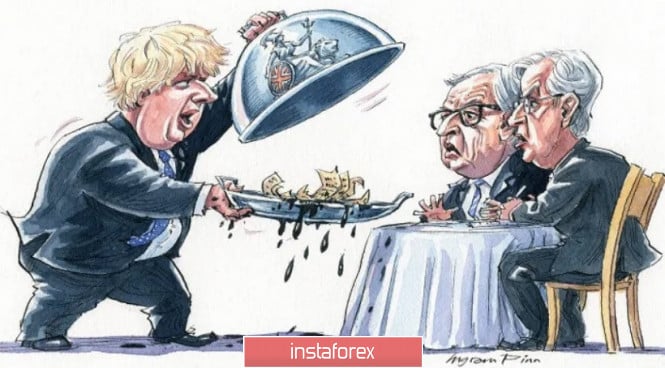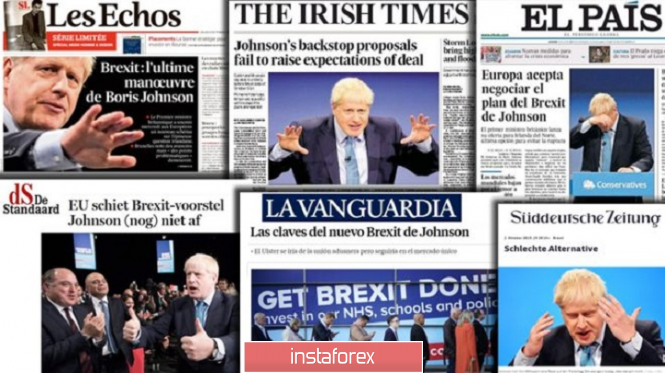Yesterday's surge in volatility for the pound-dollar pair was due not only to the Brexit theme. The US currency continues to demonstrate its vulnerability amid a slowdown in important economic indicators and in anticipation of the release of Nonfarms. This combination of fundamental factors made it possible for GBP/USD bulls to update the weekly high and approach the 24th figure. Nevertheless, the further growth of the pair remains in doubt: if today's data on the US labor market comes out in the "green zone", the dollar will quickly regain its position throughout the market. Moreover, if it is supported by Federal Reserve Chairman Jerome Powell, who will voice his opinion at the close of the US session (18:00 London time). The situation with Brexit is even more complicated. Cautious optimism in this matter can instantly be replaced by habitual pessimism, after which the pound will return to the price range of 1.2000-1.2250. There are certain prerequisites for this.

By and large, yesterday's optimism of GBP/USD traders was explained by one factor: rumors appeared in the British press that the Conservative Party and their temporary allies from the Democratic Union Party were ready to support Boris Johnson's new Brexit proposals. But it is worth noting here that, firstly, such rumors over the 3.5 years of the epic of the negotiation process have often not been confirmed. Secondly, in Europe they were rather skeptical about the initiatives of the British prime minister. And although the head of the European Commission called the voiced proposals "a breakthrough," many facts suggest otherwise. Almost all experts, politicians and journalists on both sides of the English Channel are confident that Johnson's "new plan" is doomed to failure.
The backstop is the root of the problem. Brexit supporters were initially against the "transparent" border between Northern Ireland and the Republic of Ireland. Instead of a back-stop indefinite mechanism, Johnson proposed an alternative - a "translucent" border. According to him, customs checks will return to the island - both on land and at sea - but they will be practically invisible to those crossing the border. Nevertheless, the border is de facto returned, and customs posts, even at a remote distance from the borders, remain customs posts, regardless of their location. This proposal does not suit many politicians - both among Europeans and among the British. In particular, the Laborites have already called Johnson's plan "terrifying."
The remaining items are also ambiguous. For example, the British prime minister proposed that the Northern Ireland Assembly (the Parliament of the region) have a veto. Local deputies must confirm the legitimacy of the agreement with the European Union at 4-year intervals; otherwise, Belfast will return to the orbit of British law. This idea was received "with hostility" both in Brussels and in Dublin. In addition, judging by the newspaper headlines in the European press, EU countries also do not support such an initiative.
Firstly, the aforementioned Assembly has not held its meetings for more than three years (!) Due to the lack of a quorum. Local political confrontations, which are protracted, blocked the work of this body. Secondly, Europeans are indignant at the very formulation of the question: in fact, a relatively small region will decide the fate of the European integration processes. And given the background to the relationship between Dublin and Belfast, it is impossible to imagine that the authorities of the Republic of Ireland agreed on such a mechanism. President of the European Council Donald Tusk has already managed to declare that in this matter he fully supports Varadkar, and the proposals of the British prime minister are "unconvincing" for him.

Another obstacle to agreeing on the "Johnson Plan" is purely technical in nature. Not only political will is needed to implement his proposals in European law. The legal approval process involves the consent of all 27 member countries of the European Union. According to the participants in previous negotiations (when Theresa May was in office), this is quite a time-consuming process. All of them unanimously argue that the parties will not have time to prepare the relevant document before the EU summit, which will take place in just two weeks.
Thus, Johnson has to solve a number of difficult tasks. First of all, he needs to convince the EU leadership, as well as representatives of the EU member countries of the need to agree on the above changes. Then the negotiating group needs in a short time - about two weeks - to prepare a legally verified document, which should be supported at the EU summit. If the British prime minister passes all these millstones, then only on October 19-20 will he bring an updated draft of the deal to London, which will need to be agreed with the deputies of the House of Commons. Here it is worth recalling that as a result of recent "purges", the Conservatives expelled more than 20 from their ranks. Therefore, Johnson will need to seek support "on the side", that is, among other deputy groups. The Labour Party has already categorically disagreed with his plan, while the positions of the other parties (except for the DUP and the representatives of Scotland) are still unknown.
In other words, the position of the British currency is currently quite precarious. Rumors of support for Conservatives and DUP provided temporary support to the pound, but long positions on the GBP/USD pair look risky: there are too many "ifs" in the way of Boris Johnson. Therefore, based on the results of Nonfarm and Jerome Powell's speech, one can consider short positions with the downward targets of 1.2270 and 1.2180 (the Kijun-sen line and the lower border of the Kumo cloud on D1, respectively). It's too early to speak about deeper kickbacks - the stages of the negotiation process over the next two weeks will "throw" the pair from side to side until the prospects of Brexit are finally determined.
The material has been provided by InstaForex Company - www.instaforex.com